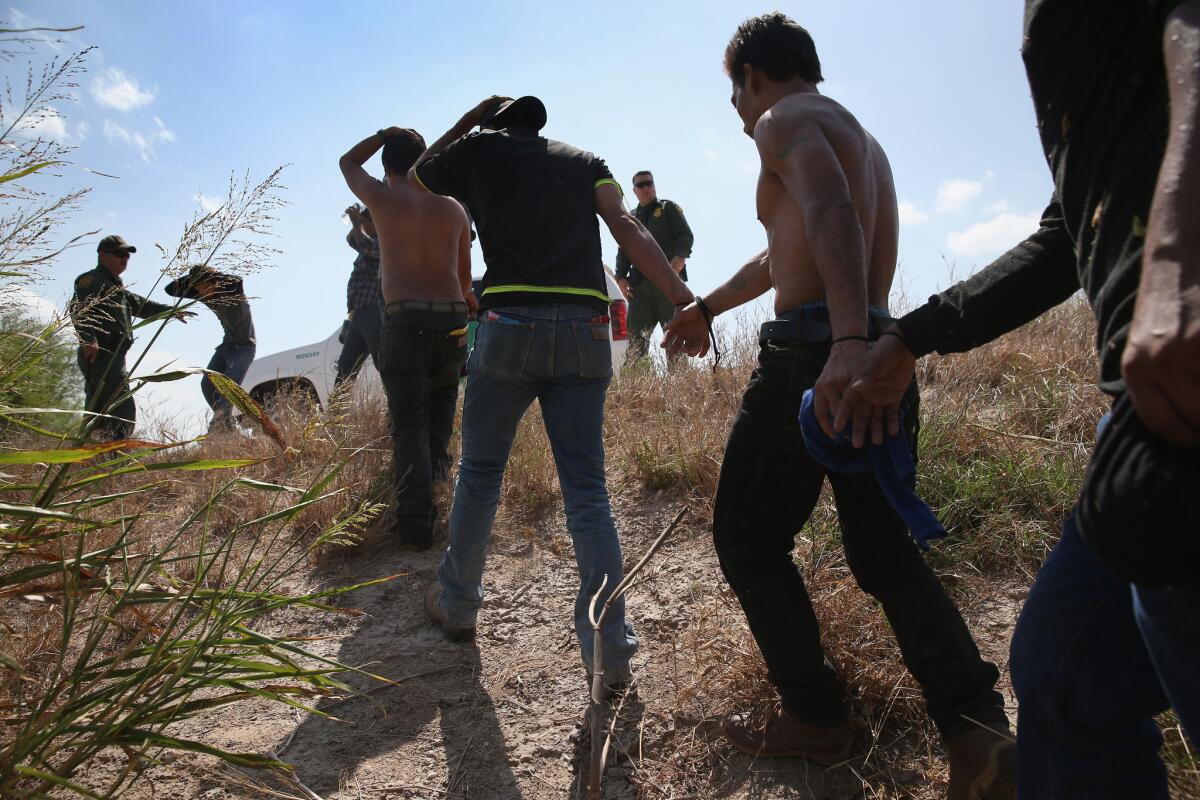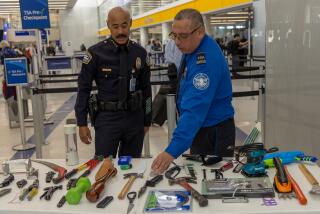Use of force by border agents declines, but shootings remain steady

U.S. Border Patrol agents detain undocumented immigrants after they crossed the border from Mexico into the United States.
Border Patrol agents and customs officers resorted to physical force less frequently in the past year, even as assaults against them increased slightly, according to official figures released Tuesday.
The decline in the use of force by agents continued a trend disclosed earlier this year after new guidelines on weapons were announced.
The decrease principally involved the use of what the Border Patrol refers to as “less lethal” weapons such as pepper-ball guns, Tasers and batons. Use of those weapons was down 27%, from 1,008 incidents in fiscal year 2014 to 740 in the fiscal year that ended Sept. 30, according to U.S. Customs and Border Protection data.
See the most-read stories this hour >>
Use of guns by border agents and officers remained steady at just over two incidents per month. Agents shot their firearms in 28 incidents in fiscal year 2015 versus 29 incidents the year before.
Violent incidents along the border remain a significant problem. On average, an assault on an agent is reported roughly once each day -- 390 in 2015, up 5% from 373 assaults on agents in 2014.
And three people have been killed in altercations with Border Patrol agents along the U.S. borders so far in calendar year 2015. Last year, four people were shot to death by Border Patrol agents, according to a tally kept by the American Civil Liberties Union’s Regional Center for Border Rights, based in Las Cruces, N.M. Four others were killed by off-duty agents in personal disputes.
The U.S. Customs and Border Protection agency, which oversees the Border Patrol, has been under pressure to reverse what its own experts have deemed to be a pattern of excessive force by agents. In April, officials pointed to reductions in the overall use of force as an indication that agents were using better judgment in the field.
R. Gil Kerlikowske, the head of U.S. Customs and Border Protection, announced new training and guidelines last year aimed at curbing abuses, as well as changes made in how use of force incidents are investigated.
“The steps we have taken over the past year -- implementing policy changes, revamping our training, standing up a new review process, and expediting the disclosure of basic information to the public -- are critical to achieving our mission and ensuring the trust of the American people,” Kerlikowske said in a statement that accompanied the new figures.
A group of police experts in 2013 reviewed the internal files for 67 deadly force cases. Their report criticized the Border Patrol for use-of-force guidelines that allowed agents far more latitude than other U.S. law enforcement officers have on when to open fire.
The report, written by the Police Executive Research Forum, found that agents had stepped in front of vehicles in order to justify opening fire and sometimes fired in frustration rather then when they faced a deadly threat.
Residents of border communities have been frustrated by the Border Patrol’s refusal to release more detailed information about agents’ use of force and whether abuse complaints result in disciplinary action. Terri Burke, executive director of the American Civil Liberties Union of Texas, called the figures released “incomplete,” saying that the CBP should follow Department of Justice guidelines and list how many times agents pointed a firearm, used physical force or broke the window of a vehicle, for example.
“CBP should use force only as a last resort, and any force used should be publicly reported and investigated to ensure that it was no more than necessary,” Burke said in a statement.
The ACLU has requested that border officials report how many times per year agents pointed a firearm, used physical force beyond handcuffing, fired a Taser, struck someone with a baton, or used other types of force. So far, U.S. Customs and Border Protection officials have refused.
Twitter: @ByBrianBennett
For more on the Border Patrol, follow @ByBrianBennett
More to Read
Start your day right
Sign up for Essential California for news, features and recommendations from the L.A. Times and beyond in your inbox six days a week.
You may occasionally receive promotional content from the Los Angeles Times.







